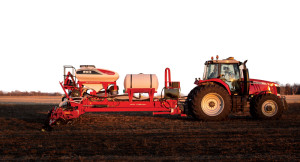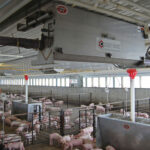Fighting Compaction: Tread Lightly
When Al Sheahan purchased a 12-row corn head last year to replace the six-row head on his combine, he had more than increased capacity in mind. He was also taking one more step toward implementing a controlled traffic farming (CTF)...
Fighting Compaction: Tread Lightly
When Al Sheahan purchased a 12-row corn head last year to replace the six-row head on his combine, he had more than increased capacity in mind. He was also taking one more step toward implementing a controlled traffic farming (CTF)...When Al Sheahan purchased a 12-row corn head last year to replace the six-row head on his combine, he had more than increased capacity in mind. He was also taking one more step toward implementing a controlled traffic farming (CTF) program and reducing compaction on the 2,800 acres he farms in partnership with neighbor Todd Myren near Nelson, Wis.

The front-axle suspension system on Massey Ferguson and other AGCO tractor brands ensures better tractive ability, reducing slip, which in turn reduces compaction.
CTF systems, which have been more prevalent in Canada, Europe and Australia, are now gaining additional converts in the U.S., and for good reason. Research in tilled soils shows approximately 75 to 80% of the increase in soil density and 90% of wheel sinkage—both of which can ultimately limit plant growth—are caused during the first pass. However, CTF can limit the compacted area to less than 15% of a given field, compared to more than 50% from some uncontrolled traffic systems.
The benefit is to a farmer’s bottom line. Australian research over 20 years has shown CTF can improve grain quality and has the potential to increase grain yields by 2 to 16%.
There are other benefits, including improving fuel and other input efficiencies. Yet, CTF often requires an investment of time and money on the front end. For instance, Sheahan and Myren have purchased a variety of equipment that allows them to confine their footprint to the fewest traffic lanes. “Because all of our machines are set up for GPS-guided autosteering on an RTK system, we can use the same wheel tracks for just about every pass,” says Sheahan.
“A lot of our equipment already fits a 30-foot pattern, so the combine was just the next step,” Sheahan says of the Massey Ferguson® 8780 he bought used. “We try to plant no-till as much as we can and limit any other tillage to vertical tillage or a field cultivator. Still, our tillage equipment is 30 feet wide; our 12-row planter covers 30 feet; the sprayer covers 60 feet; and our RoGator,® which we use to apply liquid nitrogen, spans 90 feet.
“We have everything set up for 30-inch rows, with four rows between the tires on just about every machine,” he explains. “We realize, of course, that there will be more compaction on those wheel-track rows, but at least it will be limited to those rows.”



